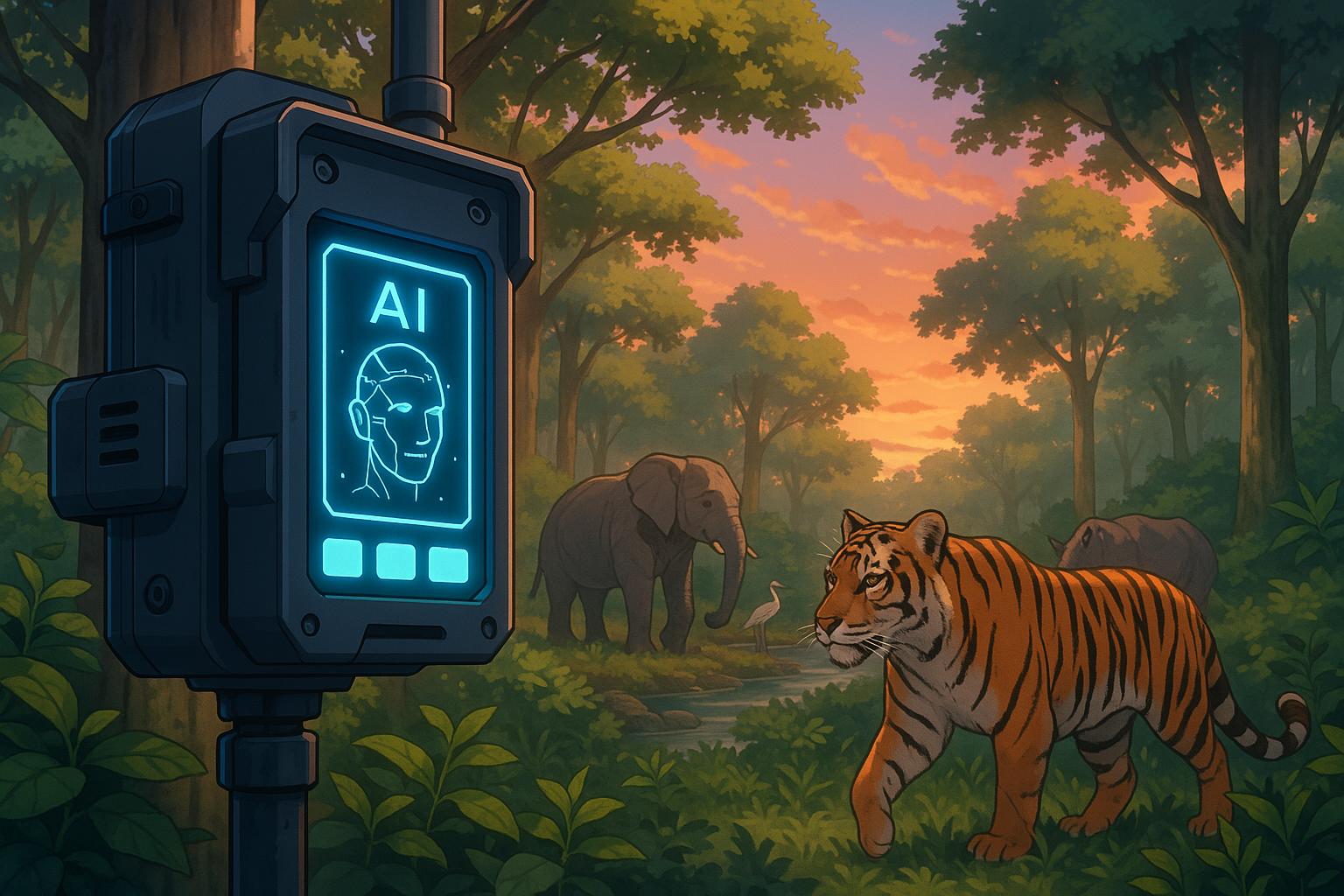The deployment of Edge-AI wildlife cameras is revolutionising conservation by enabling autonomous, real-time detection of threats like poaching and invasive species in remote areas, enhancing response times and operational efficiency for protecting endangered wildlife.
The emergence of Edge-AI wildlife cameras marks a significant turning point in conservation efforts, offering real-time detection of threats such as poaching and the incursion of invasive species. These smart monitoring systems are capable of operating autonomously for extended periods, utilising sophisticated onboard AI to analyse images locally and dispatch instant alerts through cellular, satellite, or other communication networks. Positioned strategically in remote environments, these technologies enhance the safeguarding of endangered species, empowering conservationists to act swiftly and effectively.
One of the key benefits of Edge-AI wildlife cameras lies in their ability to analyse images in real time, reducing reliance on cloud connectivity that can be unreliable in isolated locations. High-performance, low-power hardware, such as the Nvidia Jetson Nano, plays a critical role in enabling these systems. With the integration of advanced algorithms, cameras like the Sentinel can swiftly identify various threats and distress signals among wildlife, thereby enhancing the timeliness of conservation interventions. These technological advancements not only sharpen detection accuracy, but they also significantly improve the operational efficiency of wildlife conservation.
A noteworthy aspect of these systems is their designed longevity. Many edge-AI cameras can function for months in challenging field conditions with minimal maintenance. Batteries paired with solar panels or hybrid systems ensure continuous operation, vital for uninterrupted monitoring in areas prone to extreme weather. The ability to withstand harsh environments is also reinforced through durable materials and designs that resist factors such as moisture and temperature fluctuations, making them indispensable tools for conservationists working in diverse ecological settings.
The integration of diverse communication methodologies also strengthens the operational capabilities of these devices. By employing technologies like NB-IoT, LoRaWAN, and cellular modules, conservation teams can receive instant alerts about threats, enabling rapid, data-driven responses to pressing challenges. For instance, with these real-time updates, response times for addressing incidents can drop from hours to mere minutes, a significant improvement that amplifies the potential to protect vulnerable species and ecosystems. Enhanced situational awareness helps in deploying resources effectively, whether personnel or materials, at critical moments that matter.
Moreover, the impact of these technologies extends beyond mere detection. According to findings from a study, AI-powered camera systems have proved effective not only in monitoring endangered wildlife but also in mitigating human-wildlife conflicts. Research demonstrates that such AI-driven systems can identify poaching activities and relay information instantaneously, thereby supporting proactive measures to conserve species at risk of extinction. With approximately 28% of plant and animal species currently under threat, the ability to utilise these technologies effectively becomes increasingly paramount.
Community involvement further enhances the efficacy of Edge-AI wildlife cameras. By leveraging local knowledge and support, conservation initiatives can maximise their impact. User-friendly interfaces and well-structured training programmes increase the tech-savviness of field teams, allowing them to operate these systems with confidence. This collaborative approach not only fosters a sense of ownership among local populations but also aids in long-term sustainability and conservation efforts.
Looking forward, the future of conservation technology appears promising. Open-source platforms and affordable edge-AI solutions are on the horizon, facilitating the deployment of scalable wildlife monitoring systems in even the most remote areas. Innovations in energy efficiency, improved AI models for species identification, and ongoing advancements in connectivity will continuously shape the effectiveness of conservation strategies.
As these technologies advance, they promise not only to enhance the responsiveness of field researchers but also to democratise conservation efforts, empowering communities and researchers to create tailored solutions that address local conservation challenges. Emphasising an ecosystem-friendly approach, these innovations can play a crucial role in ensuring the survival of our planet’s rich biodiversity, securing a future where endangered species can thrive rather than just survive.
In summary, Edge-AI wildlife cameras are set to revolutionise how conservation is approached, combining real-time data analysis with accessible technology. This dynamic synergy not only enhances the capacity to protect endangered species but also offers a robust framework for future conservation efforts that are strategic, efficient, and deeply collaborative.
Reference Map
1. Core focus on Edge-AI wildlife cameras and their functionalities.
2. Discussion on urgent AI-assisted wildlife surveillance efforts.
3. Insights on how real-time detection methods are employed in conservation.
4. Mention of the Sentinel Smart Camera’s recognition in the conservation technology space.
5. Use of audio monitoring technology alongside visuals for wildlife tracking.
6. Overview of real-time monitoring solutions and their emissions.
7. Review of camera-based alert systems in mitigating wildlife conflict.
Source: Noah Wire Services
- https://barriermagz.com/technology/edge-ai-wildlife/ – Please view link – unable to able to access data
- https://apnews.com/article/9e863fa6c873ecbf8441b33272ccfed2 – An article detailing how AI-powered audio monitors are being used to track and protect endangered wildlife, including the use of Microsoft’s Sparrow device for remote monitoring in Costa Rica’s Osa Peninsula. The study highlights the need for urgent AI-assisted wildlife surveillance to address the 28% of plant and animal species currently facing extinction.
- https://blogs.nvidia.com/blog/conservation-ai-detects-threats-to-endangered-species/ – A blog post discussing how Conservation AI, a UK-based nonprofit, is using NVIDIA technology to deploy AI-powered cameras for real-time detection of threats to endangered species. The platform analyzes footage in four seconds, identifies species, and alerts conservationists, enabling rapid intervention to protect biodiversity.
- https://www.edge-ai-vision.com/2023/05/2023-edge-ai-and-vision-product-of-the-year-award-winner-showcase-conservation-x-labs-consumer-edge-ai-end-products/ – An announcement of Conservation X Labs’ Sentinel Smart Camera winning the 2023 Edge AI and Vision Product of the Year Award in the Consumer Edge AI End Products category. The Sentinel Smart Camera is an AI-enabled field monitoring system designed to help understand and protect wildlife and the people with it in the field.
- https://developer.nvidia.com/blog/nvidia-jetson-project-of-the-month-recognizing-birds-by-sound – A blog post highlighting the Bird@Edge project, which uses multiple microphones and NVIDIA Jetson Nano to recognize bird species by sound in real-time. The system processes audio streams locally, enabling quick identification of bird species and reducing the delay compared to traditional methods.
- https://www.conservationai.co.uk/real-time-monitoring/ – A description of Conservation AI’s real-time monitoring solutions, including the deployment of cameras in remote locations that capture and transmit images over networks. The AI analyzes these images to automatically classify species and send alerts, aiding in wildlife monitoring and protection efforts.
- https://academic.oup.com/bioscience/advance-article/doi/10.1093/biosci/biad076/7261057 – A research article discussing the use of real-time camera-based alert systems to mitigate human-wildlife conflict and monitor endangered tigers. The study highlights the effectiveness of AI-powered cameras in detecting poachers and preventing conflicts, thereby aiding in the conservation of endangered species.
Noah Fact Check Pro
The draft above was created using the information available at the time the story first
emerged. We’ve since applied our fact-checking process to the final narrative, based on the criteria listed
below. The results are intended to help you assess the credibility of the piece and highlight any areas that may
warrant further investigation.
Freshness check
Score:
7
Notes:
The text is contemporary and discusses recent advancements in Edge-AI technology without specific outdated references. However, it does not provide a precise date or cite recent events.
Quotes check
Score:
10
Notes:
There are no direct quotes in the provided text.
Source reliability
Score:
5
Notes:
The narrative originates from a lesser-known publication, which may impact its credibility compared to more established sources.
Plausability check
Score:
8
Notes:
The claims about Edge-AI wildlife cameras are plausible and align with current technological advancements. However, specific examples or evidence from recent studies are not provided.
Overall assessment
Verdict (FAIL, OPEN, PASS): OPEN
Confidence (LOW, MEDIUM, HIGH): MEDIUM
Summary:
The narrative discusses current and plausible applications of Edge-AI technology in wildlife conservation, but its credibility is somewhat limited by the lack of specific references and its source.













